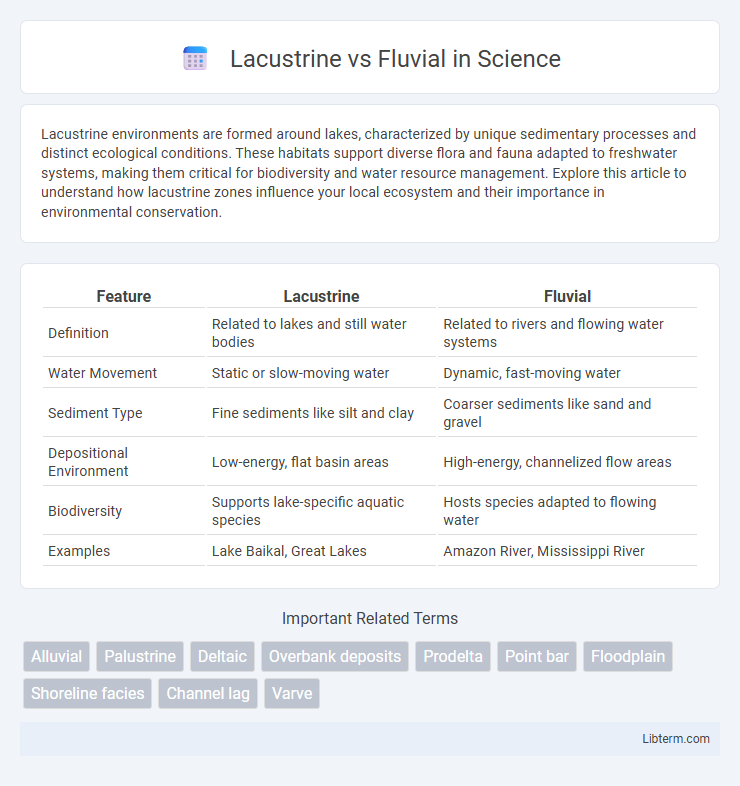Lacustrine environments are formed around lakes, characterized by unique sedimentary processes and distinct ecological conditions. These habitats support diverse flora and fauna adapted to freshwater systems, making them critical for biodiversity and water resource management. Explore this article to understand how lacustrine zones influence your local ecosystem and their importance in environmental conservation.
Table of Comparison
| Feature | Lacustrine | Fluvial |
|---|---|---|
| Definition | Related to lakes and still water bodies | Related to rivers and flowing water systems |
| Water Movement | Static or slow-moving water | Dynamic, fast-moving water |
| Sediment Type | Fine sediments like silt and clay | Coarser sediments like sand and gravel |
| Depositional Environment | Low-energy, flat basin areas | High-energy, channelized flow areas |
| Biodiversity | Supports lake-specific aquatic species | Hosts species adapted to flowing water |
| Examples | Lake Baikal, Great Lakes | Amazon River, Mississippi River |
Introduction to Lacustrine and Fluvial Systems
Lacustrine systems refer to sedimentary environments associated with lakes, characterized by relatively still water facilitating fine sediment deposition and preservation of organic material. Fluvial systems encompass river and stream environments where flowing water shapes the landscape, transports sediment, and deposits coarser materials in channels and floodplains. Understanding these systems is crucial for interpreting sedimentary structures, paleoenvironmental conditions, and resource distribution such as freshwater reservoirs and hydrocarbon traps.
Defining Lacustrine Environments
Lacustrine environments are characterized by sedimentary deposits formed in lake settings, where calm water conditions promote fine-grained sediment accumulation such as clay, silt, and carbonate minerals. Unlike fluvial environments dominated by river and stream processes with coarser sediments like sand and gravel, lacustrine settings often preserve distinct varves and organic-rich layers indicating seasonal changes. These environments support unique ecosystems and play a critical role in carbon sequestration through the burial of organic material in lake basins.
Characteristics of Fluvial Environments
Fluvial environments are characterized by the processes of river and stream flow that shape landscapes through erosion, transportation, and deposition of sediments. These environments typically feature channelized water flow, variable sediment sizes ranging from fine silt to larger gravel, and dynamic riverbanks with floodplains that support diverse ecosystems. Unlike lacustrine settings, fluvial systems exhibit continuous water movement and temporal changes in channel morphology influenced by hydrological variations.
Geological Processes: Lacustrine vs Fluvial
Lacustrine geological processes involve sediment deposition in lake environments, characterized by fine-grained sediments such as clays, silts, and organic-rich materials settling in relatively calm water. Fluvial geological processes occur in river and stream systems, featuring sediment transport and deposition driven by flowing water, producing coarser materials like sand, gravel, and channel bar deposits. Differences in energy dynamics and sediment supply between lacustrine and fluvial settings create distinct stratigraphic patterns and sedimentary structures key to interpreting past environmental conditions.
Sediment Deposition in Lakes vs Rivers
Lacustrine sediment deposition occurs in lake environments where fine-grained sediments like clays and silts settle from still water, creating well-layered, often organic-rich deposits. Fluvial sediment deposition takes place in river systems, characterized by variable flow velocities that transport and deposit coarser materials such as sand and gravel, forming channel bars, point bars, and levees. The contrast in energy levels between lacustrine and fluvial settings results in distinct sedimentary facies and stratigraphic architectures that are critical for interpreting past environmental conditions.
Biological Diversity: Lakes Compared to Rivers
Lacustrine ecosystems, such as lakes, generally host higher biodiversity and more stable habitats than fluvial environments like rivers, due to their slower water movement and stratified nutrient layers that support diverse aquatic species. Lakes provide critical breeding grounds for numerous fish, amphibians, and invertebrates, as well as rich microbial communities that enhance nutrient cycling. In contrast, rivers exhibit rapid water flow and frequent disturbance, creating specialized niches but often limiting species richness compared to lacustrine systems.
Climate Influence on Lacustrine and Fluvial Systems
Climate plays a crucial role in shaping lacustrine and fluvial systems by controlling precipitation patterns, temperature regimes, and runoff rates. In lacustrine environments, climate influences lake water levels, salinity, and sediment deposition, often leading to variegated sedimentary records that reflect historical climate fluctuations. Fluvial systems respond to climate through changes in river discharge, sediment load, and channel morphology, which directly affect flood frequency and ecosystem dynamics.
Morphological Differences: Lake Basins vs River Channels
Lacustrine environments feature broad, enclosed lake basins with relatively flat bottoms and gently sloping shorelines, promoting sediment deposition and fine-grained sediment accumulation. Fluvial systems consist of narrow, dynamic river channels with variable cross-sections, including meanders, riffles, and pools, shaping sediment transport and erosion patterns. The morphological differences between lake basins and river channels influence hydrodynamics, sediment distribution, and ecosystem habitats in distinct ways.
Environmental and Economic Significance
Lacustrine environments, characterized by lake systems, support diverse aquatic ecosystems and act as natural reservoirs for freshwater, essential for agriculture, drinking water, and fisheries, contributing significantly to local economies. Fluvial systems, consisting of rivers and streams, play a crucial role in sediment transport, nutrient cycling, and maintaining biodiversity, while facilitating irrigation, hydropower generation, and transportation corridors that drive regional economic development. Both environments are vital for sustaining ecosystem services, influencing land use, and supporting livelihoods dependent on water resources and fertile soils.
Summary: Key Differences Between Lacustrine and Fluvial
Lacustrine environments refer to sedimentary deposits formed in lake settings characterized by fine-grained, often laminated sediments due to low energy conditions, while fluvial environments involve river and stream systems with coarser, well-sorted sediments deposited through higher energy processes. Key differences include sediment texture and sorting, energy levels driving deposition, and typical sedimentary structures, with lacustrine sediments exhibiting finer particles and fluvial sediments showing cross-bedding and channel structures. These distinctions influence the fossil content, mineralogy, and stratigraphic architecture critical for geological and environmental analyses.
Lacustrine Infographic

 libterm.com
libterm.com